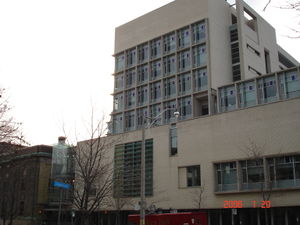Bahen Centre for Information Technology
| Bahen Centre for Information Technology | |
|---|---|
 | |
| Location | 40 St. George Street |
| Year Constructed | 2002 |
| Building Code | BA |
| Major Offices/Labs | |
| Division of Engineering Science | |
| Office of the Dean | |
| Adel Sedra Auditorium | |
| Advanced Surface Coatings Laboratory | |
| Bell University Laboratories | |
| Dynamic Graphics Project | |
| Emerging Communications Technology Institute | |
| Reconfigurable Antennas Laboratory | |
The Bahen Centre for Information Technology, located on 40 St. George Street, was completed in 2002 and serves as a "state of the art facility for education of information technology professionals in electrical and computer engineering, computer science and IT research." It was constructed at a cost of $111 million, and was designed by Diamond + Schmitt Architects Incorporated. The building is home to the Division of Engineering Science and is adjoined to the Koffler Centre on the south, which houses the U of T Bookstore and U of T Career Centre, and 44 St. George St. on the north, a historic house-like building that currently contains the Office of the Dean (and formerly the Professional Experience Year office).
Departments and Offices
- Division of Engineering Science (BA2110)
- Office of the Dean (44 St. George Street)
- Adel Sedra Auditorium (BA1160)
Notable Laboratories
- Advanced Surface Coatings Laboratory
- Bell University Laboratories
- Dynamics Graphics Project
- Emerging Communications Technology Institute
- Reconfigurable Antennas Laboratory (BA8177)
Structure and Design
The Bahen Centre was built on the site of several historic buildings south of Russell Street, and adjacent to the preexisting Koffler Student Centre, whose exterior brick wall became an interior feature of the new building. One of the historic buildings (44 St. George Street) was to be moved to a new location, but was instead incorporated into the design by the architects.
The facility is 20,000 gross square metres and has been praised for its sustainability in design. Many elements of the Bahen Centre contribute its overall sustainability. The building uses excess steam from the neighbouring U of T steam plant to provide 92% of its total heating needs and sun-shading devices along both the east and south sides of the building reduce the amount of cooling needed during the summer months. In addition, careful space planning allows for the labs of the computer science and Electrical and Computer Engineering departments to face the coolest wall (north) to provide relief from the heat created by the large numbers of computers.
History
The Bahen Centre was constructed to meet the growing needs of the university's computer science and electrical and computer engineering programs, as the university doubled the size and funding of the programs. The building is named after engineer John Bahen (Civ 5T4), former president of Kiewit Corporation, who made a significant gift to support the project. Other sources of private funding included Jeffrey Skoll, the engineering class of 4T5, and companies including Nortel Networks, Bell Canada, and Motorola, who have named research labs in the building.
The facility contains 50 laboratories, 10 lecture theatres, 13 tutorial rooms, 9 seminar rooms, and about 300 offices. The building was officially opened on October 8, 2002, after opening in the summer of 2002. The sixth floor, however, was finished only in August 2005 and the Department of Mathematics (and the Mathematics Library) moved in.
Awards and Accolades
- Canadian Architect magazine, January 2003 - "[The building is] a complex interweaving of urbanity, public space and sustainability."
- Ontario Association of Architects Award, 2003 - Winner
- City of Toronto Architecture and Urban Design Award, 2003 - Winner
- National Post Design Exchange Award, Environmental Category - Bronze
- Building Magazine Outside the Box Awards, Urban Design, 2005 - Honourable Mention
References
- Canadian Architect, January 2003. “Green Giant.” Marco Polo
- University of Toronto. Bahen Centre for Information Technology [1], 2006.